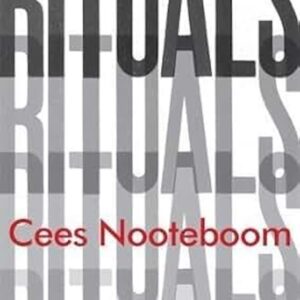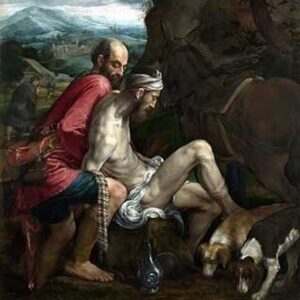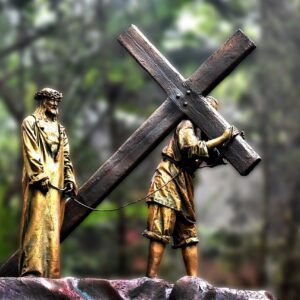I somehow grew up without reading the Narnia books. I read just about every other fantasy I could get my hands on, and when that wasn’t enough started inventing my own, but Narnia I never touched. I scarcely heard of C. S. Lewis until I was fourteen. At that time, my father went through a sort of religious crisis and read Surprised by Joy and Mere Christianity. He almost became a Christian. I remember heated discussions with him about some of the ideas in the latter book. I can date my interest in theology and religion from that epoch. But my father didn’t convert after all, and I didn’t think of Lewis again for six years.
Lewis the Apologist has never interested me. I did eventually try reading Surprised by Joy—when I was beginning my own intellectual path into Christianity, no less. But I couldn’t get into the book. In recent years I have taken to using The Screwtape Letters to teach writing, because that book is a masterpiece of rhetoric. That’s all I have to do with Lewis the Apologist.
Lewis the Storyteller is another matter. His Space Trilogy is excellent and haunting. I would sooner re-read Perelandra than its model, Paradise Lost. The final book of the trilogy, That Hideous Strength, only seems more prescient as we slouch further toward a posthuman future. It is also one of the most unique and ambitious modern contributions to the Arthurian tradition, equal to those of Arthur Machen, T.H. White, John Cowper Powys, Mary Stewart, Rosemary Sutcliff, and Marion Zimmer Bradley.
Lewis’s last fiction, Till We Have Faces, a version of a late Greek myth, is also excellent fantasy, but of a very different nature, comparable to David Lindsay’s Voyage to Arcturus or Hope Mirrlees’s Lud in the Mist. The material that has grown up around Arthur pertains to epic, tragedy, romance; those shorter fantasies, like the last Lewis wrote, lie in the province of myth. In that regard I might also put Till We Have Faces in the company of Reb Nachman’s and George MacDonald’s fiction: visionary and modern yet influenced by fairy and folk tale.
Perhaps the most unusual of Lewis’s books is his edition of Charles Williams’s Arthurian poetry, Arthurian Torso. There is the mysterious brilliance of Williams’s poetry itself—imagine a twentieth-century William Blake obsessed with Arthuriana. Lewis weaves that work into the larger Arthurian tradition, which is the West’s most ancient, most symbolically charged and most culturally distinctive story cycle. But apart from that achievement, I am struck by Lewis’s charity in preparing the volume.
How many writers would expend such effort and expertise in elucidating and—to use a renaissance term I like to think Lewis would appreciate—defending a peer whose peculiar genius is apt to be neglected? (For that word, think of Sir Philip Sidney’s Defense of Poetry or Joachim Du Bellay’s equally pivotal Defense and Illustration of the French Language.) To turn one’s scholarship upon one’s peer and contemporary.… I’ve thought of writing a book for the sake of the great Catholic fantasist R. A. Lafferty, or to introduce Annette von Droste-Hülshoff to the English-speaking world. But it’s easy to feel magnanimous toward the long since deceased. C. S. Lewis actually knew the brilliant but bizarrely faulty Charles Williams.
That Lewis could recognize Williams’s genius speaks to Lewis’s sensitivity—as a storyteller himself—to myth, symbol, and the traditional forms of fiction. It speaks just as much to his acumen as a scholar. I mean scholar in the sense of one endowed with great humanity and imagination (Lewis might prefer I say fantasy), such that he is able to study his material with sympathy. He is similar in this regard to his peer, Helen Waddell. It is a rare figure nowadays. Lewis the Scholar is the Lewis closest to my heart, for without him I would never have encountered Lewis the Storyteller.
To return to the tale of my discovery of C. S. Lewis: After my encounter with him as an adolescent, I didn’t again pick up one of his books until one late night while wandering in the stacks of the library at my undergraduate alma mater. I was enrolled in a course in sixteenth century literature that was at that time reading Spenser. I had become entranced by Spenser’s romance epic, The Faerie Queene. No one else in the course seemed to share my passion for this poem. We read the first of its six enormous books; but I had to keep going to the end. Taking a break from that reading, I wandered among the shelves of books and saw a title that caught my eye: The Allegory of Love. This was Lewis’s first academic work, and I fell under its spell as surely as under Spenser’s, in part because Lewis clearly had great love and understanding of Spenser.
That was twenty years ago. Though I plan soon to revisit The Allegory of Love, now I’m reading Lewis’s last books. His last scholarly book, The Discarded Image (published posthumously) was composed from a course of lectures which he gave multiple times at Oxford. A better introduction to the medieval cosmos—what he variously calls a model or an image—cannot be found. It is a philosophical book, and subtly elegiac. Lewis is clear about the beauty he finds in the medieval cosmos; he is also clear that there shall be no return to it. I’m reading The Discarded Image for the sake of my own current book project. One of the points I make there is that Lewis may have been wrong: the medieval cosmos may not be permanently defunct but merely in abeyance. A new version of a living cosmos is slowly emerging, and has been hiding all the while in the kind of literary fantasy that Lewis loved and furthered in his own work.
I’m also reading the last book he published in his lifetime, the brief but profound and poignant notebook he kept after his wife died, A Grief Observed. What is the term for the opposite of a conversion memoir? For that is what this book is, and it affects me as Surprised by Joy did not. When he lost his wife to cancer, Lewis’s faith was tried, and this last book is the lucid and honest record of that trial. “You never know how much you really believe anything until its truth or falsehood becomes a matter of life and death to you.”
What Lewis discovered was that his faith had been, as he put it, a house of cards, imagination rather than faith. He was a great one, after all, for the image, the fantasy, the symbol. In his grief, Lewis saw that reality is iconoclastic; God is the supreme iconoclast. “I need Christ, not something that resembles him. I want H., not something that is like her.” In the pitch of such a grief (and Lewis realized that it is inevitable for all lovers), the problems and mysteries of religion and art are one and the same. All images shall be discarded at last. May we remember this, all of us scholars and artists and lovers.
Jonathan Geltner lives in Ann Arbor MI with his wife and two sons. His translation of Paul Claudel’s Five Great Odes is available from Angelico Press and a novel, Absolute Music, is forthcoming from Slant. If you enjoy his posts at Close Reading, check out his new Substack, Romance and Apocalypse, for more frequent and in-depth essays on the places where literature and other arts meet religious ideas and experience.





